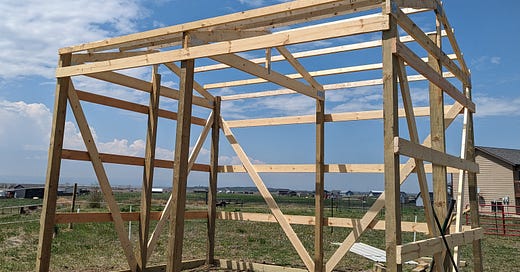One year ago, I was standing at the back of our brand new property, watching the sunset. While I gazed at our first home, I had this feeling like I was sitting at the highest point of a roller coaster, peeking over the edge right before the free-fall. The timeline for developing our horse acreage felt inhuman. For one, my husband was having a surgery in two months time that would leave him non-weight bearing for an extended period. Additionally, the clock was ticking on how long I could continue to board my mare. I was planning to purchase a yearling from a breeder in our area, and she offered to let Nikki integrate into their herd, ensuring that her new buddy would be a good match before they came home. But with foaling season and their other prior commitments on the horizon, that meant our horses would need to come home before July. Plus, we were on a very tight budget, and so we were planning on installing all of the fencing as well as the shelter ourselves. I had never even held a t-post driver. How on earth would we be able to pull this off?
Yet, exactly two months later, every H-brace was set, every fence insulator was secured, and every line of perimeter fence was strung. We were so proud of the loafing shed we built from scratch that we began to nick name it “The Horse Mansion.” The pace with which we worked to turn our dream into a reality was enervating. Literal blood and tears were shed at times, and I have the scars to remind me. We certainly learned a log along the way, so here are some tips I would share with anyone about to embark on a similar journey, especially if timelines, budgets, or both are tight.
Visualize Your Plan
I have very fond memories of sitting shoulder to shoulder at the kitchen table with my husband, pouring over Google Earth images of our land. As soon as we put an offer in on our house, I purchased Jaime Jackson’s book Paddock Paradise and began learning the basics of keeping horses on a track system - a fabulous option for those living on small acreage. And so, getting a sense of where to put lines of fence, as well as how much material would be needed, helped us start budgeting. In the beginning, I was thrust into one mini crash course after another, like pricing and installation options for various fencing types and planning the proper sizing and direction for a shelter based on factors like herd size, prevailing winds, and weather. I would use the Google Earth measurement tools to draw out each small decision we made over time until the puzzle pieces started to click into place. As I read Jackson’s track system book, I did a lot of doodling with pen and paper too, dreaming up where I might place hay stations, salt licks, play areas, and so on, so that way I was always keeping in mind the larger vision for our land. Mapping your property in this way can help keep each small decision grounded in the larger trajectory of your planning and management.
Invest in Efficiency and Safety
I love a budget. We’re pretty thrifty in my household, and so spending outside of the “necessities” was hard for us during this season. We certainly needed fence posts, but investing in a two-person auger to dig the holes for them felt like a stretch. However, after one afternoon of attempting to manually move ground with a post hole digger, it became evident that the time we would save greatly outweighed the unexpected cost. We carried this lesson with us through the coming months. For instance, when I needed to scale the top of the shelter to secure the roof panels, we went out and purchased an emergency ladder. It has been collecting dust in a corner of our house ever since then, but I don’t regret spending extra money to make things safer. So keep your financial goals in sight, but give yourself permission to pay for things that will keep you on task and in one piece along the way.
Accept Help from Your Community
In the beginning, we had multiple friends offer to help us with our projects around the farm. I certainly struggled with feeling like accepting that help would burden the people in our lives. Initially, we only borrowed a few things that word offered to us, like an extra t-post driver from a coworker, or a tamper from a neighbor. But as the weeks unfolded, it became clear that we simply would not be able to complete our projects on the timeline we were working on without assistance. Pretty soon, we had friends showing up to hang gates, dig trenches, and pound nails. The fencing went up, the loafing shed was erected, and the property came to life. All the while, we had pizza parties and shared cold beers in exchange for our community’s time, energy, and support. By accepting help, we fostered trust, demonstrated vulnerability, and reinforced the bond of mutual support. These connections feel deeper and more meaningful to me having shared the highs and lows of that season with others.
Work With Mother Nature, Not Against Her
As I write this post, we are under a high wind warning here on the prairie. Currently, the winds are upwards of 40 mph, with gusts up to 70 mph. This is a somewhat common occurence in our area. We faced these sorts of conditions last year, too; the winds often kicked up right as we were ready to climb a ladder, secure a truss, or screw down a roof panel. Go figure. So, we maintained our flexibility, often setting the alarm for 5 AM to put in a little time before work when the winds were lowest. Check your forecast, understand the climate you’re working in, and adjust accordingly. There’s something serene about working your land while intimately learning the cycles of nature. Embrace the uncertainty of not just the forecast, but of how the process ahead of you will unfold. When you look back, you’ll remember the beauty more than the precariousness of it all.






